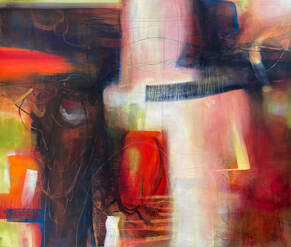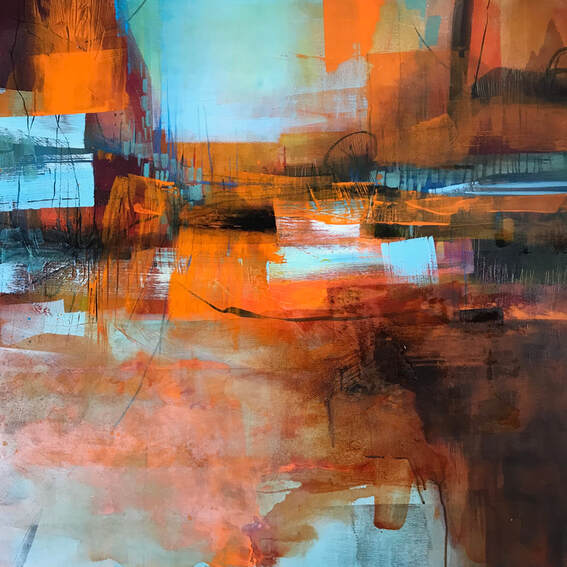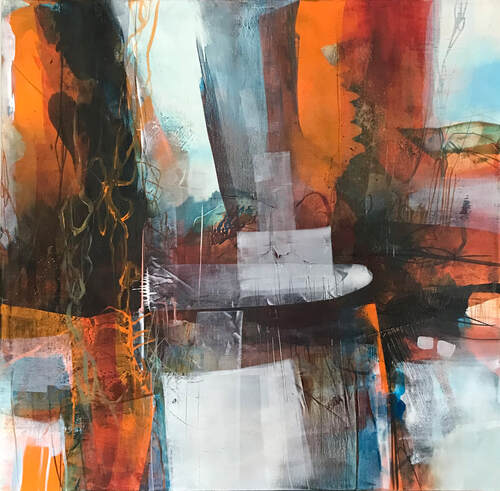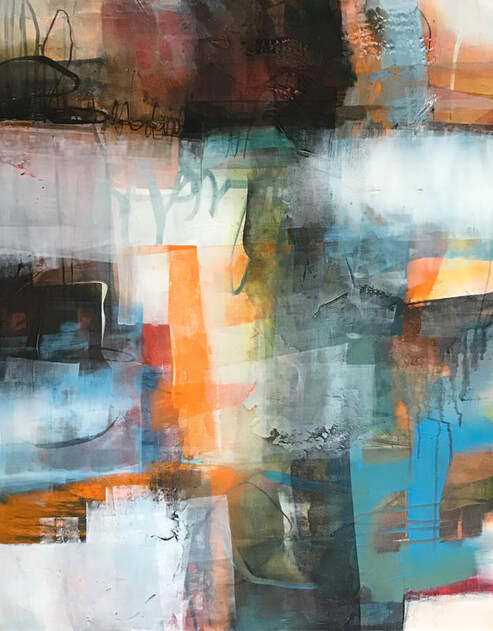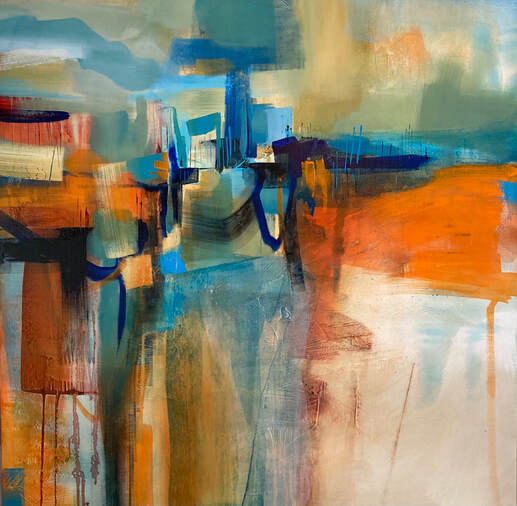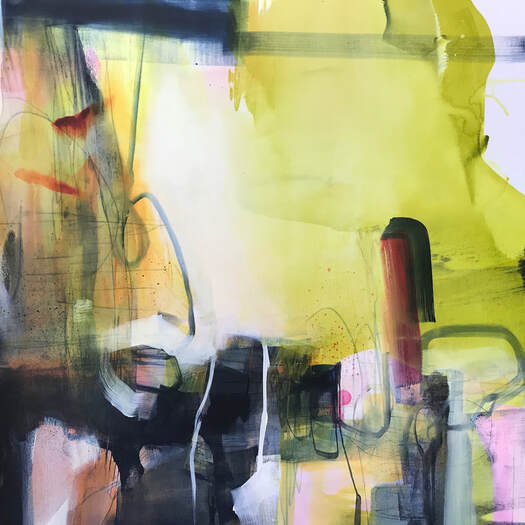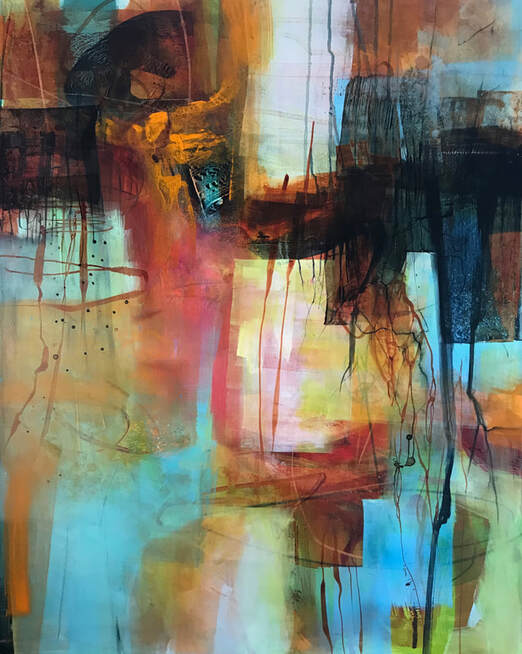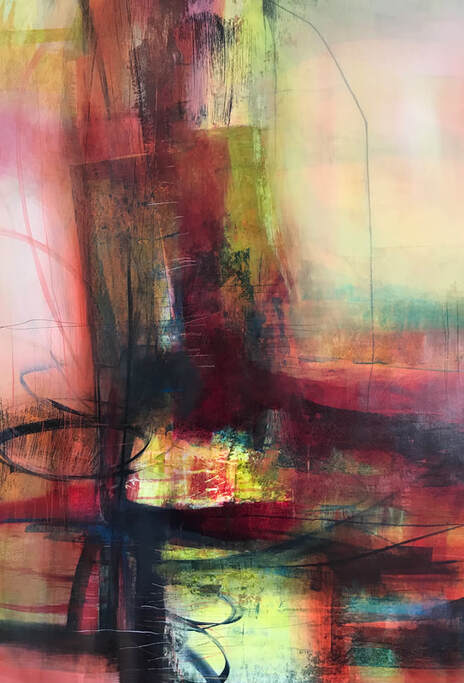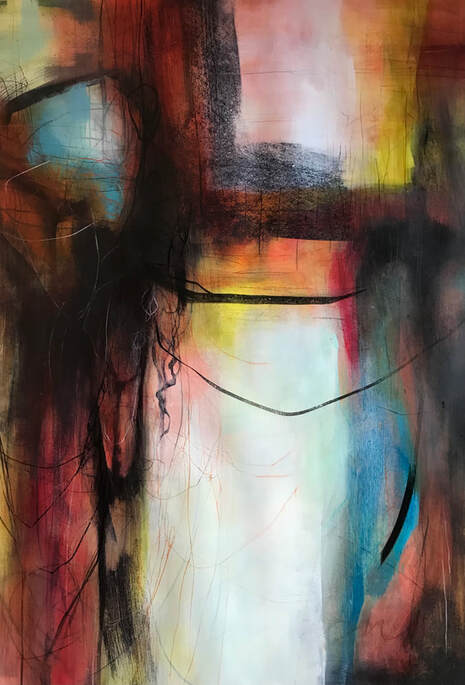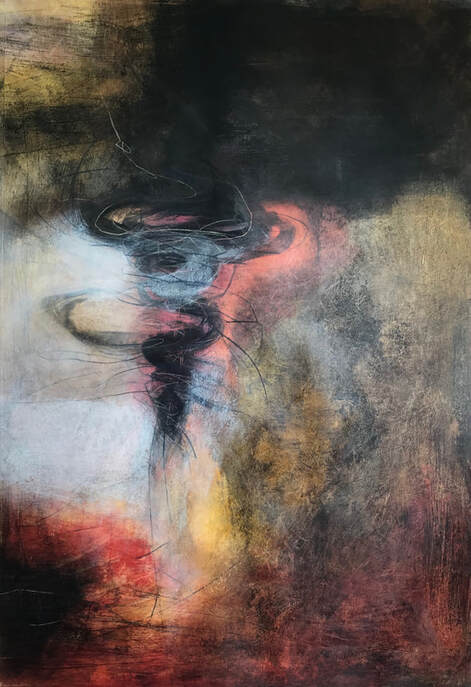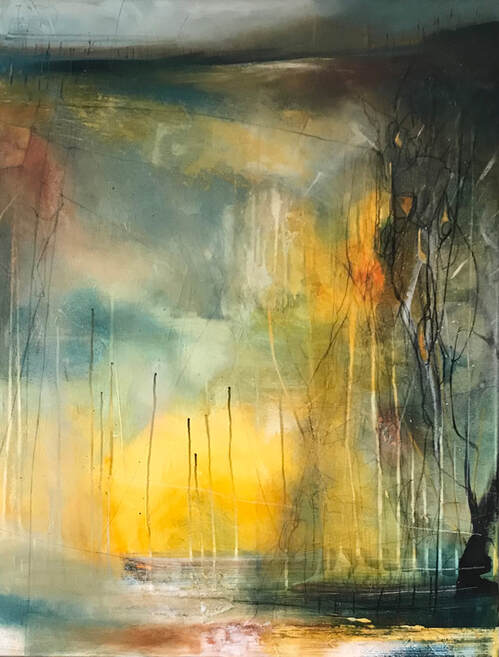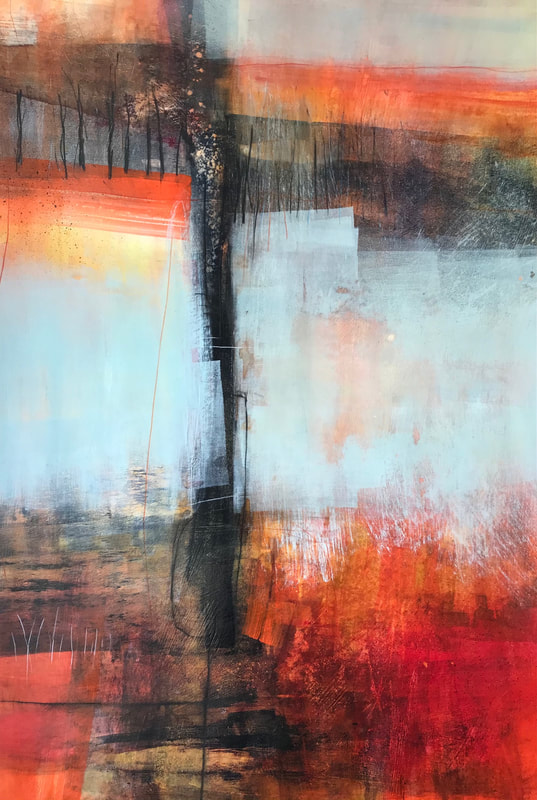Journey Through 2021 Acrylic on canvas, 120x100cm
Claire Murray
“Another World”
A very recent discovery by Max Laniado, Claire Murray is an English artist living and working in West Yorkshire (England.)
Promoted and represented worldwide by Max Laniado Fine Arts, Claire Murray has taken the public by storm in only a few months.
With great mastery, Claire brings her feelings and vision of the world through an original expressionist abstraction. Beautiful colors, textures, subtle transparencies in harmonious compositions.
“Another World”
A very recent discovery by Max Laniado, Claire Murray is an English artist living and working in West Yorkshire (England.)
Promoted and represented worldwide by Max Laniado Fine Arts, Claire Murray has taken the public by storm in only a few months.
With great mastery, Claire brings her feelings and vision of the world through an original expressionist abstraction. Beautiful colors, textures, subtle transparencies in harmonious compositions.
TNYO: My first question is, what is abstraction to you?
Claire Murray: Abstraction gives the viewer a challenge - and requires them to really look, think, and engage with the piece to attempt to read the work. For me, abstraction is about interpreting shape, form, tone, and colour. There has to be some kind of connection to what we perceive as real, but my vision is my own, emerging and developing on the canvas organically. It took me a long time to move away from observation and reality as sources for my ideas, as I am a skilled drafts person who always tries to impart skill and quality in my work, whether abstract, semi-abstract, or even realist.
Claire Murray: Abstraction gives the viewer a challenge - and requires them to really look, think, and engage with the piece to attempt to read the work. For me, abstraction is about interpreting shape, form, tone, and colour. There has to be some kind of connection to what we perceive as real, but my vision is my own, emerging and developing on the canvas organically. It took me a long time to move away from observation and reality as sources for my ideas, as I am a skilled drafts person who always tries to impart skill and quality in my work, whether abstract, semi-abstract, or even realist.
Unspeakable 2021 Acrylic on canvas, 80x80cm
TNYO: With a major in Fine Art, why did you choose to work in abstraction?
Claire Murray: My degree was in fine art, painting, and working in abstraction offered me the opportunity to explore ideas of place, space, spatial relationships, and landscape while being ambiguous and playful with meaning. The potential for the viewer to interpret is essential in the creation of an exciting painting, and making a realist painting always felt a little like offering an idea on a plate to the viewer and anchoring too much meaning there. I love allowing for misunderstanding, ambiguity, and choice in meaning and interpretation.
Initially, I chose a fine art degree to take the opportunity to explore a wide range of visual art approaches. In those days (the late 80s), a fine art degree offered me the chance to study printmaking, painting, sculpture, and time-based media in the first year, before specialising in the second and third years. I love all kinds of 2D and 3D expressions, but painting drew me in, and I’ve never looked back. In 21st century parlance, I think my degree would now be classed as a ‘contemporary art’ degree and include much less painting (if any) and more conceptual ideas and digital media.
I also took a Master’s degree in Fine Art in the early 90’s and explored postmodernist theory, conceptual ideas, and working with a wide range of materials from paint, sculpture, photography, film, sound, and found objects. During this time, I was exposed to a more academic approach to art, and as a postgraduate, I quite enjoyed the idea of art as an idea, not a commodity as such. Ultimately though, this way of working was somehow quite empty and perhaps too self-consciously in vogue as a long-term approach. Painting had become unfashionable, even dead, according to some. But I love an underdog, and I guess I rebelled at the idea that painting had nowhere new to go, so I returned to it with a passion. I, at least, still had a lot of painting to do.
TNYO: Can you tell us a little bit about your background and how it has influenced your work?
Claire Murray: Ah, I would love to tell you about my exotic roots, but actually, I hail from a very ordinary and humble working-class background in the north of England. I think my working-class sensibilities lie behind why it took me so many years to be confident enough to become a full-time artist, that somehow that life wasn’t for the likes of me. A sort of impostor syndrome, perhaps, or just a slow-starter!
I think my connection with nature comes straight from my childhood in rural northeast England, where I lived with my parents and brother, riding horses, and living much of my life outdoors. We had very little money, which has definitely influenced my attitude to the way I run my studio - I’m thrifty and can’t stand waste! My box of collage papers is huge and contains all kinds of little cut-off papers which would have found their way to the recycling bin in anyone else’s home! And I’m very careful with my paints and equipment, especially anything expensive. I don’t think that ever really goes away, and I’m forever grateful to have a roof over my head and food on the table. It’s a huge privilege to be able to work as an artist but not something I’d ever take for granted.
I’ve been lucky to have traveled in my life, met some extraordinary people along the way who have inspired me, believed in me, and have ultimately helped me grow into the person I am today.
TNYO: Who are some of your favorite artists, and how have they influenced you?
Claire Murray: Since my student days, I have loved the work of Gerhard Richter, Peter Lanyon, Graham Sutherland, Helen Frankenthaler, Barbara Hepworth, Robert Rauschenberg, Rothko, and Jasper Johns, and later, Andrew Wyeth and Kurt Jackson. I follow many contemporary painters on Instagram too, but I think my references are still rooted in 20th-century abstraction.
I feel a strong connection to the St Ives group of painters in Cornwall (Ben Nicholson, Terry Frost, Barbara Hepworth, Peter Lanyon, Patrick Heron, Wilhelmina Barnes-Graham, et al.) I recall visiting St Ives when I was about 19 and being so inspired by the light, the landscape, colours, and especially the work of Peter Lanyon. I remember taking a roll of film and an SLR camera and coming back with images of dry stone walls, ancient standing stones, and cerulean blue skies. I think that was a pivotal moment that started my journey here.
These quotes from Peter Lanyon really resonated with me, and the approach I take when creating my own paintings, often referred to as abstract landscapes; “(my paintings) … use abstraction as a method and landscape experience as a source…(they) reject the conventions of landscape but remain recognisable with the country. They are concerned with the environment rather than view, and with air rather than sky”. Lanyon believed it was “a painter’s business…to understand space - the ambient thing around us”. And, “I like to paint places where solids and fluids come together, such as the meeting of sea and cliff, of wind and rock, of human body and water.” [Peter Lanyon, in At The Edge of Landscape, by Chris Stephens].
TNYO: Where are you currently located?
Claire Murray: I’m based in rural Yorkshire, on the edge of the moors and the South Pennine hills. It’s a dramatic landscape that has inspired and spawned many artists and writers before me - from Ted Hughes, the Brontes, David Hockney, to Henry Moore, and many more.
Claire Murray: My degree was in fine art, painting, and working in abstraction offered me the opportunity to explore ideas of place, space, spatial relationships, and landscape while being ambiguous and playful with meaning. The potential for the viewer to interpret is essential in the creation of an exciting painting, and making a realist painting always felt a little like offering an idea on a plate to the viewer and anchoring too much meaning there. I love allowing for misunderstanding, ambiguity, and choice in meaning and interpretation.
Initially, I chose a fine art degree to take the opportunity to explore a wide range of visual art approaches. In those days (the late 80s), a fine art degree offered me the chance to study printmaking, painting, sculpture, and time-based media in the first year, before specialising in the second and third years. I love all kinds of 2D and 3D expressions, but painting drew me in, and I’ve never looked back. In 21st century parlance, I think my degree would now be classed as a ‘contemporary art’ degree and include much less painting (if any) and more conceptual ideas and digital media.
I also took a Master’s degree in Fine Art in the early 90’s and explored postmodernist theory, conceptual ideas, and working with a wide range of materials from paint, sculpture, photography, film, sound, and found objects. During this time, I was exposed to a more academic approach to art, and as a postgraduate, I quite enjoyed the idea of art as an idea, not a commodity as such. Ultimately though, this way of working was somehow quite empty and perhaps too self-consciously in vogue as a long-term approach. Painting had become unfashionable, even dead, according to some. But I love an underdog, and I guess I rebelled at the idea that painting had nowhere new to go, so I returned to it with a passion. I, at least, still had a lot of painting to do.
TNYO: Can you tell us a little bit about your background and how it has influenced your work?
Claire Murray: Ah, I would love to tell you about my exotic roots, but actually, I hail from a very ordinary and humble working-class background in the north of England. I think my working-class sensibilities lie behind why it took me so many years to be confident enough to become a full-time artist, that somehow that life wasn’t for the likes of me. A sort of impostor syndrome, perhaps, or just a slow-starter!
I think my connection with nature comes straight from my childhood in rural northeast England, where I lived with my parents and brother, riding horses, and living much of my life outdoors. We had very little money, which has definitely influenced my attitude to the way I run my studio - I’m thrifty and can’t stand waste! My box of collage papers is huge and contains all kinds of little cut-off papers which would have found their way to the recycling bin in anyone else’s home! And I’m very careful with my paints and equipment, especially anything expensive. I don’t think that ever really goes away, and I’m forever grateful to have a roof over my head and food on the table. It’s a huge privilege to be able to work as an artist but not something I’d ever take for granted.
I’ve been lucky to have traveled in my life, met some extraordinary people along the way who have inspired me, believed in me, and have ultimately helped me grow into the person I am today.
TNYO: Who are some of your favorite artists, and how have they influenced you?
Claire Murray: Since my student days, I have loved the work of Gerhard Richter, Peter Lanyon, Graham Sutherland, Helen Frankenthaler, Barbara Hepworth, Robert Rauschenberg, Rothko, and Jasper Johns, and later, Andrew Wyeth and Kurt Jackson. I follow many contemporary painters on Instagram too, but I think my references are still rooted in 20th-century abstraction.
I feel a strong connection to the St Ives group of painters in Cornwall (Ben Nicholson, Terry Frost, Barbara Hepworth, Peter Lanyon, Patrick Heron, Wilhelmina Barnes-Graham, et al.) I recall visiting St Ives when I was about 19 and being so inspired by the light, the landscape, colours, and especially the work of Peter Lanyon. I remember taking a roll of film and an SLR camera and coming back with images of dry stone walls, ancient standing stones, and cerulean blue skies. I think that was a pivotal moment that started my journey here.
These quotes from Peter Lanyon really resonated with me, and the approach I take when creating my own paintings, often referred to as abstract landscapes; “(my paintings) … use abstraction as a method and landscape experience as a source…(they) reject the conventions of landscape but remain recognisable with the country. They are concerned with the environment rather than view, and with air rather than sky”. Lanyon believed it was “a painter’s business…to understand space - the ambient thing around us”. And, “I like to paint places where solids and fluids come together, such as the meeting of sea and cliff, of wind and rock, of human body and water.” [Peter Lanyon, in At The Edge of Landscape, by Chris Stephens].
TNYO: Where are you currently located?
Claire Murray: I’m based in rural Yorkshire, on the edge of the moors and the South Pennine hills. It’s a dramatic landscape that has inspired and spawned many artists and writers before me - from Ted Hughes, the Brontes, David Hockney, to Henry Moore, and many more.
Rusted 2021 Acrylic on canvas, 100 x 80 cm
Elemental 2021 Acrylic on canvas, 80x80cm
Poète du Terroir 2021 Acrylic on canvas, 100x80cm
TNYO: You are a very beautiful and talented woman. I am sure our audience would love
to know what your relationship status is.
Claire Murray: That’s very kind of you! I’m happily married to Adam.
TNYO: If you were not a full-time artist, what would you be?
Claire Murray: I was a college art teacher for 15 years, which was extremely fulfilling, interesting, and varied, and I loved developing creative young minds and helping to guide them towards an exciting future. So in practical terms, I’d probably be doing that if I wasn’t a full-time artist. In a different life altogether, I’d love to be a musician and perform all around the world.
TNYO: What materials do you work with?
Claire Murray: I love working in a wide range of different materials and enjoy 2D and 3D. I love working in oils, but the quality of acrylic paint now is superb, and the quick drying time means that I can achieve the results I want more easily. My sketchbooks are full of work made with collage, watercolours, ink, acrylic, pencil crayon, pen, fine liner, graphite, and many non-traditional mark-making media. I also love to weave poetry and quotes into, under, and within my paintings, but often the meanings are hard to read and the words difficult to make out. I love to hint at a meaning without spelling out the whole, leaving a certain ambiguity in place.
TNYO: Can you share what your painting process is?
Claire Murray: My painting process is quite complex as there is no set formula to my approach. I don’t have an endpoint or particular outcome in mind from the outset of a new piece, but the process will drive the painting. It’s a very intuitive process that is quite difficult to pin down and explain in words, but I’ll try!
For my abstracts, I start by applying a layer of texture, usually gesso, but sometimes I’ll add plaster, texture paste, and collage materials (I love using raw and fraying silk). At this point, I won’t have any particular composition in mind, so the surface texture is kind of random. However, nothing is really random so that the texture will be balanced across the canvas, thicker in places, thinner in others, with areas of ‘busyness’ and others of ‘calm,’ or negative/positive space. The finished surface then becomes the starting point for the new painting. I’ve got my favorite colors, and I’m really interested in colour relationships - e.g., how they harmonize, clash, complement one another - and exploring colour to push those rules and boundaries.
My starting point often begins with expressive lines and initial splashes and swipes of paint - this is always gestural and completely abstract to start from a truly free place. I often use water spray, squeegees, rags, allowing for drips, merging colour, often tilting the canvas this way and that, to generate a sense of movement. There’s certain alchemy involved at this point, and I love it when happy accidents of fluidity and pigment come together in a new and fascinating way. If I’m patient, I’ll wait until this initial layer is completely dry before layering more transparent colors on top of one another, gaining intensity and depth as each layer blends with the one underneath. This process takes time and patience and works really well with quick-drying acrylics. When I’m using oils, the process is quite different, and it can take weeks and weeks to work through a similar approach, as drying times are much slower. I find the artwork is different, too, as the spontaneity is sometimes lost, but it is often replaced by a calmer, perhaps more considered outcome. Either way, the painting is driven by process, not outcome.
As I develop a piece, my brushes get smaller, the marks begin to refine, line and detail are added, and the composition begins to solidify. At the moment, I am really drawn to contrasts - especially light and dark, soft and hard, fluidity and solidity, transparency and opacity, line, texture, and smoothness. The last mark, line, stain, or drip, happens when I can’t see where I would add anything else, and the composition is balanced and feels complete.
Sometimes I might finish a painting, and I can see that it’s competent, maybe too ‘nice’, but is somehow not enough. If it’s not doing it for me, then (after a period of reflection) I’ll return to it with boldness, and actually sometimes a recklessness, to push that painting further, well beyond my comfort zone. Some of my best paintings have emerged from this process, as I have taken a much more courageous approach.
I am an avid photographer and literally have thousands of photos on my phone and computer, which act as reference points and loose observational resources to draw upon when doing new work. Only when teaching do I work directly from a photo, preferring instead to work from memory, feeling, and instinct.
to know what your relationship status is.
Claire Murray: That’s very kind of you! I’m happily married to Adam.
TNYO: If you were not a full-time artist, what would you be?
Claire Murray: I was a college art teacher for 15 years, which was extremely fulfilling, interesting, and varied, and I loved developing creative young minds and helping to guide them towards an exciting future. So in practical terms, I’d probably be doing that if I wasn’t a full-time artist. In a different life altogether, I’d love to be a musician and perform all around the world.
TNYO: What materials do you work with?
Claire Murray: I love working in a wide range of different materials and enjoy 2D and 3D. I love working in oils, but the quality of acrylic paint now is superb, and the quick drying time means that I can achieve the results I want more easily. My sketchbooks are full of work made with collage, watercolours, ink, acrylic, pencil crayon, pen, fine liner, graphite, and many non-traditional mark-making media. I also love to weave poetry and quotes into, under, and within my paintings, but often the meanings are hard to read and the words difficult to make out. I love to hint at a meaning without spelling out the whole, leaving a certain ambiguity in place.
TNYO: Can you share what your painting process is?
Claire Murray: My painting process is quite complex as there is no set formula to my approach. I don’t have an endpoint or particular outcome in mind from the outset of a new piece, but the process will drive the painting. It’s a very intuitive process that is quite difficult to pin down and explain in words, but I’ll try!
For my abstracts, I start by applying a layer of texture, usually gesso, but sometimes I’ll add plaster, texture paste, and collage materials (I love using raw and fraying silk). At this point, I won’t have any particular composition in mind, so the surface texture is kind of random. However, nothing is really random so that the texture will be balanced across the canvas, thicker in places, thinner in others, with areas of ‘busyness’ and others of ‘calm,’ or negative/positive space. The finished surface then becomes the starting point for the new painting. I’ve got my favorite colors, and I’m really interested in colour relationships - e.g., how they harmonize, clash, complement one another - and exploring colour to push those rules and boundaries.
My starting point often begins with expressive lines and initial splashes and swipes of paint - this is always gestural and completely abstract to start from a truly free place. I often use water spray, squeegees, rags, allowing for drips, merging colour, often tilting the canvas this way and that, to generate a sense of movement. There’s certain alchemy involved at this point, and I love it when happy accidents of fluidity and pigment come together in a new and fascinating way. If I’m patient, I’ll wait until this initial layer is completely dry before layering more transparent colors on top of one another, gaining intensity and depth as each layer blends with the one underneath. This process takes time and patience and works really well with quick-drying acrylics. When I’m using oils, the process is quite different, and it can take weeks and weeks to work through a similar approach, as drying times are much slower. I find the artwork is different, too, as the spontaneity is sometimes lost, but it is often replaced by a calmer, perhaps more considered outcome. Either way, the painting is driven by process, not outcome.
As I develop a piece, my brushes get smaller, the marks begin to refine, line and detail are added, and the composition begins to solidify. At the moment, I am really drawn to contrasts - especially light and dark, soft and hard, fluidity and solidity, transparency and opacity, line, texture, and smoothness. The last mark, line, stain, or drip, happens when I can’t see where I would add anything else, and the composition is balanced and feels complete.
Sometimes I might finish a painting, and I can see that it’s competent, maybe too ‘nice’, but is somehow not enough. If it’s not doing it for me, then (after a period of reflection) I’ll return to it with boldness, and actually sometimes a recklessness, to push that painting further, well beyond my comfort zone. Some of my best paintings have emerged from this process, as I have taken a much more courageous approach.
I am an avid photographer and literally have thousands of photos on my phone and computer, which act as reference points and loose observational resources to draw upon when doing new work. Only when teaching do I work directly from a photo, preferring instead to work from memory, feeling, and instinct.
Prospect 2021 Acrylic on canvas, 80x80cm
Machine 2021 Acrylic on canvas, 100x100cm
High Nick 2021 Acrylic on canvas, 92x71cm
The Dreamer 2021 Acrylic on canvas, 100x80cm
Deconstructed 2021 Acrylic on paper, 100x70cm
TNYO: How did you come in contact with Max Laniado?
Claire Murray: Max saw my work online, loved what he saw, and approached me directly.
TNYO: How important is god and the universe in your life and your work:
Claire Murray: That’s an interesting question! The universe is extremely important as my work attempts to understand and interpret the world, existence, and our role in this life. God as a religious figure does not mean anything to me personally, but I feel a strong spiritual connection to the planet and our existence as a species. I believe in natural energy, life force, and spirituality, and I think some of that manifests in my paintings on some level. However, I consider myself a non-believer in organised religion.
TNYO: Do you believe in or have seen ghosts and spirits?
Claire Murray: I haven’t seen a ghost before, but that doesn’t mean they’re not there.
TNYO: Do you have an inner voice or an outer voice that speaks to you?
Claire Murray: My inner voice gives me courage when I’m scared. It tells me to be brave, to get on with it and jump, to take a risk. Don’t give up, don’t be a wuss. I love my inner voice! It allows me, no, instructs me to grow.
TNYO: Where do you see yourself in five years, 10 years?
Claire Murray: Well, if the last 18 months have taught me anything, it’s that who knows what the future holds?! If I could really choose my future, I’d be healthy and happy, surrounded by my family and friends, and painting in a huge, light studio, preferably somewhere warm near mountains and sea…
TNYO: Can you choose a favorite song for our audience to listen to that may connect with your work?
Claire Murray: This is the hardest question of all as I love many songs, but it isn’t easy to choose one to connect with the work. At the moment I’m listening a lot to John Grant’s album, Queen of Denmark, as he was the last live musician, I saw just last month. I especially love the track “Where Dreams Go to Die” but figured it might be too melancholy, so I’m going to say anything by the Esbjorn Svensson Trio (EST) for the incredible and intense energy in their music.
Claire Murray: Max saw my work online, loved what he saw, and approached me directly.
TNYO: How important is god and the universe in your life and your work:
Claire Murray: That’s an interesting question! The universe is extremely important as my work attempts to understand and interpret the world, existence, and our role in this life. God as a religious figure does not mean anything to me personally, but I feel a strong spiritual connection to the planet and our existence as a species. I believe in natural energy, life force, and spirituality, and I think some of that manifests in my paintings on some level. However, I consider myself a non-believer in organised religion.
TNYO: Do you believe in or have seen ghosts and spirits?
Claire Murray: I haven’t seen a ghost before, but that doesn’t mean they’re not there.
TNYO: Do you have an inner voice or an outer voice that speaks to you?
Claire Murray: My inner voice gives me courage when I’m scared. It tells me to be brave, to get on with it and jump, to take a risk. Don’t give up, don’t be a wuss. I love my inner voice! It allows me, no, instructs me to grow.
TNYO: Where do you see yourself in five years, 10 years?
Claire Murray: Well, if the last 18 months have taught me anything, it’s that who knows what the future holds?! If I could really choose my future, I’d be healthy and happy, surrounded by my family and friends, and painting in a huge, light studio, preferably somewhere warm near mountains and sea…
TNYO: Can you choose a favorite song for our audience to listen to that may connect with your work?
Claire Murray: This is the hardest question of all as I love many songs, but it isn’t easy to choose one to connect with the work. At the moment I’m listening a lot to John Grant’s album, Queen of Denmark, as he was the last live musician, I saw just last month. I especially love the track “Where Dreams Go to Die” but figured it might be too melancholy, so I’m going to say anything by the Esbjorn Svensson Trio (EST) for the incredible and intense energy in their music.
Corrupted 2021 Acrylic on paper, 100x70cm
Chasm 2021 Acrylic on paper, 100x70cm
The Storm 2020 Acrylic on paper, 100x70cm
Storm Over A Broken Hillside 2020 oil on canvas, 100x80cm
The Bridge 2020 Acrylic on paper, 100x70cm





